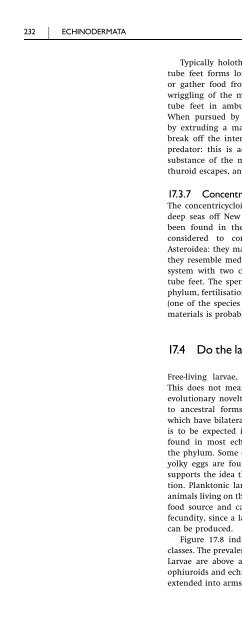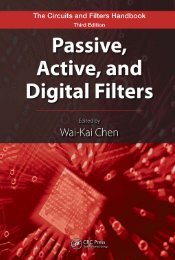An Introduction to the Invertebrates, Second Edition - tiera.ru
An Introduction to the Invertebrates, Second Edition - tiera.ru
An Introduction to the Invertebrates, Second Edition - tiera.ru
Create successful ePaper yourself
Turn your PDF publications into a flip-book with our unique Google optimized e-Paper software.
232 ECHINODERMATATypically holothuroids are deposit feeders. A group of anteriortube feet forms long buccal tentacles that are held out as a ne<strong>to</strong>r ga<strong>the</strong>r food from <strong>the</strong> sand. Locomotion is slow, by worm-likewriggling of <strong>the</strong> muscular body wall, or <strong>the</strong>re may be locomo<strong>to</strong>rtube feet in ambulacral grooves on <strong>the</strong> underside of <strong>the</strong> body.When pursued by preda<strong>to</strong>rs, holothuroids may immobilise <strong>the</strong>mby ext<strong>ru</strong>ding a mass of very sticky blind-ending tubules, or maybreak off <strong>the</strong> internal organs and leave <strong>the</strong>m in <strong>the</strong> path of <strong>the</strong>preda<strong>to</strong>r: this is achieved by complete slackening of <strong>the</strong> groundsubstance of <strong>the</strong> mutable connective tissue. The rest of <strong>the</strong> holothuroidescapes, and regenerates its viscera.17.3.7 ConcentricycloideaThe concentricycloids (sea daisies) were discovered only in 1986 indeep seas off New Zealand; a second species of Xyloplax has nowbeen found in <strong>the</strong> Caribbean. Concentricycloidea are at presentconsidered <strong>to</strong> constitute a separate class closely related <strong>to</strong>Asteroidea: <strong>the</strong>y may even be placed within that class. Superficially<strong>the</strong>y resemble medusae (Figure 17.7c) but <strong>the</strong>re is a water vascularsystem with two connected concentric rings, one of which bearstube feet. The sperma<strong>to</strong>zoa are very unusual and, uniquely in <strong>the</strong>phylum, fertilisation may be internal. Feeding methods are unknown(one of <strong>the</strong> species has no gut) but absorption of dissolved organicmaterials is probably important.17.4 Do<strong>the</strong>larvaeilluminateechinodermevolution?Free-living larvae, in most phyla, are simpler than <strong>the</strong> adults.This does not mean that <strong>the</strong>y represent ancestral forms; <strong>the</strong>y areevolutionary novelties, adapted <strong>to</strong> <strong>the</strong>ir own way of life. Reference<strong>to</strong> ancestral forms is especially tempting in those echinodermswhich have bilaterally symmetrical larvae but bilateral symmetryis <strong>to</strong> be expected in motile animals. Motile plank<strong>to</strong>nic larvae arefound in most echinoderms, and are believed <strong>to</strong> be primitive <strong>to</strong><strong>the</strong> phylum. Some of <strong>the</strong> species that instead develop directly fromyolky eggs are found <strong>to</strong> contain vestigial larval st<strong>ru</strong>ctures, whichsupports <strong>the</strong> idea that direct development is a secondary specialisation.Plank<strong>to</strong>nic larvae are an advantage <strong>to</strong> sessile or slow-movinganimals living on <strong>the</strong> sea bot<strong>to</strong>m, because <strong>the</strong>y can exploit a differentfood source and can disperse <strong>the</strong> species. They also allow greaterfecundity, since a large number of small eggs without food reservescan be produced.Figure 17.8 indicates <strong>the</strong> larvae characteristic of <strong>the</strong> differentclasses. The prevalence of convergent evolution is instantly apparent.Larvae are above all adapted <strong>to</strong> <strong>the</strong>ir own way of life. That bothophiuroids and echinoids have a ‘pluteus’ larva with <strong>the</strong> ciliary bandextended in<strong>to</strong> arms by eight skeletal rods does not mean that brittle











